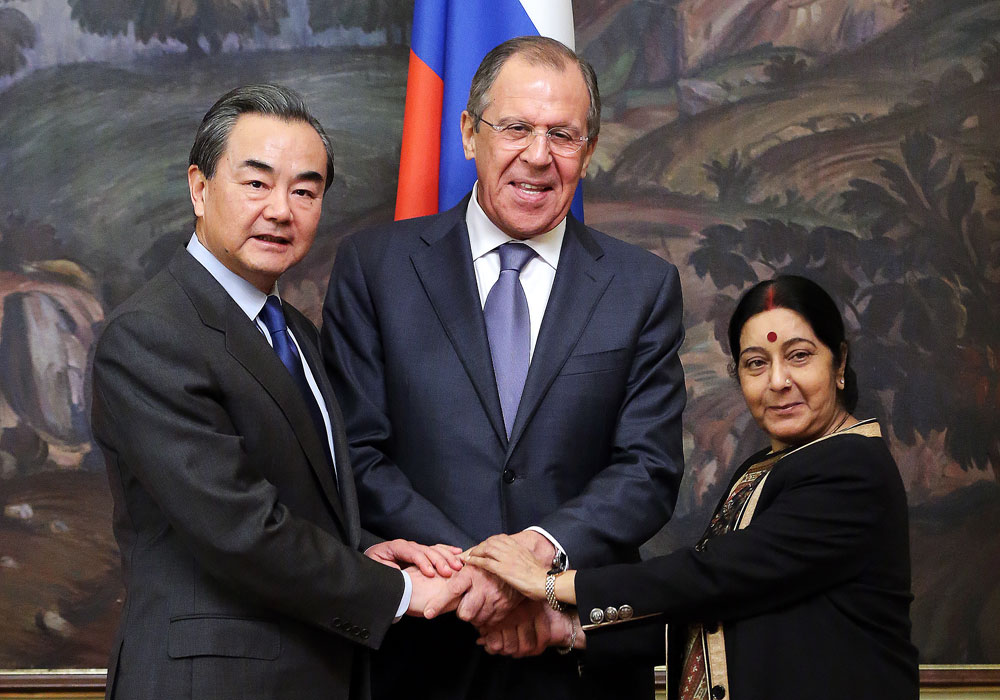
China's Foreign Minister Wang Yi, Russia's Foreign Minister Sergei Lavrov, and India's Foreign Minister Sushma Swaraj (L-R) ahead of the 14th Russia-India-China (RIC) meeting of foreign ministers.
Sergei Savostyanov / TASSThe Russian capital on Monday April 18 hosted a meeting of the foreign ministers of Russia, India and China as part of the regular RIC dialogue. Sergey Lavrov, Sushma Swaraj, and Wang Yi discussed the situation in the Middle East, UN reforms, and other pressing international problems.
"Even though this is not an anniversary [summit], the number of events conducted so far demonstrates that the RIC mechanism remains sought-after and works in an effective manner. This is a dialogue platform which has become an important factor in global politics," Lavrov said while opening the discussions.
That this kind of conference is held every year would indicate that the three countries are committed to the idea of a multi-polar world. The participants in this “troika” are subjected to pressure from the United States. India is additionally concerned about close ties between the Chinese and Pakistani militaries. This makes this a shaky format, Russian journalist and Orientalist Vladimir Skosyrev writes in Nezavisimaya Gazeta.
On the eve of talks in Moscow, the Chinese newspaper Global Times, which is published by the Communist Party, published an article in which they compared India with a female – who wants to be the most beautiful woman in the world. This woman wants to be courted by the two most powerful countries in the world; the USA and China. A few days ago, India entered into an agreement with Washington that allows the Americans to use bases in India for refueling of their ships and aircraft. India has now sent Defence Minister Manohar Parrikar to Beijing for talks.
This is a familiar role for India, the newspaper continues. She also manoeuvred between the two military blocs during the Cold War. Today, the international media claim that India has entered the same boat with the United States to contain China.
These types of sarcastic comments do not reflect a high degree of confidence that Delhi and Beijing nourish for each other. It is well known that the Indians are very suspicious of the fact that China supplies weapons to Pakistan, and that from time to time sends its warships into the Indian Ocean. And then there is a conflict within the walls of the United Nations, concerning the terrorist Masood Azhar, who has carried out terrorist attacks against Indian targets, and is who now safely living in Pakistan.
In 2001, the United Nations had declared the Jaish-e-Mohammad, headed by Masood, a banned organization. This year, the leader of these armed fanatics organized an attack on an Indian Air Force Base in Pathankot. Delhi then demanded that the UN Sanctions Committee place Masood on the list of known terrorists. However, China, as a permanent member of the Security Council, blocked this proposal, stating that it did not fall within the mandate of the Security Council. According to the Indian news agency PTI, Sushma Swaraj, in the strongest possible terms, expressed her government’s dissatisfaction to the Chinese foreign minister.
Nevertheless, Tatyana Shaumyan, head of the Indian Research Center at the Institute of Oriental Studies, in an interview with Nezavisimaya Gazeta, positively assessed the value of this meeting. “It is very important that the three foreign ministers keep the tradition of tripartite meetings. There exist problems, both international and bilateral, and common positions are being developed. Then there are issues on which differences remain unresolved between the countries, but the members of this forum are still willing to discuss their positions, on the basis of own national interests.”
The main thing here is that the current format is preserved, rather than what decisions are actually taken there. Very significant also is the cooperation of these three countries within the BRICS and the SCO (Shanghai Cooperation Organization). With India formally becoming a member of the SCO, another platform for negotiations has also available. Pakistan will also become a member.
Regarding the “tilt” of China towards Pakistan, the expert says that this does not hamper the relations within the “troika”. China has its relationship with Pakistan, but relations within the RIC (Russia, India, China) is another matter. Therefore, it is not surprising that the Chinese have repeatedly expressed to the Indians that their relationship with Islamabad will have no effect on Beijing’s normalization of relations with New Delhi. It must be kept in mind that the RIC format is the core of a larger structure, the BRICS.
While some Chinese commentators have called the US-India agreement on bases a step towards the conclusion of an informal military alliance between the USA and India, by contrast, in Delhi, they argue that the course being followed by Narendra Modi’s government will allow the country to expand the horizons of its foreign policy, and increase the international influence of India.
It is being looked upon as a strategic position, compared to its partnership relations within the RIC. The US, in order to contain China, is not only trying to get its traditional allies in the Asia-Pacific Region onboard, but also neutral countries, which have territorial disputes with Beijing. At the same time, Russia is subjected to American pressure on the Ukrainian question. Against this background, Delhi has fairly large freedom of manoeuvre, writes the Indian magazine Outlook.
Based on materials from the Nezavisimaya gazeta.
All rights reserved by Rossiyskaya Gazeta.
Subscribe
to our newsletter!
Get the week's best stories straight to your inbox